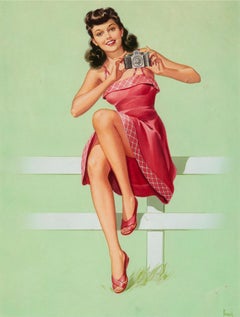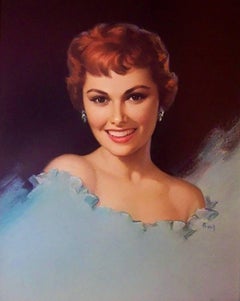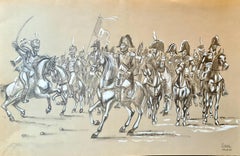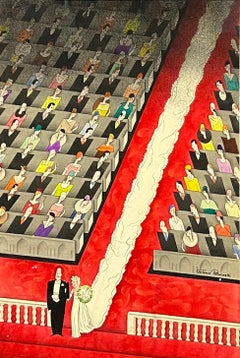Pearl Frush Drawings and Watercolor Paintings
to
1
1
Overall Width
to
Overall Height
to
2
1
1
1
2
2
1
1
1
1
1
1
1
1
2
2
1
1
1
2
970
401
280
279
1
2
Artist: Pearl Frush
Pin Up Girl in Red Dress, Mid-Century, Female Artist
By Pearl Frush
Located in Miami, FL
The Pin-Up of ravishing young beauties in mid-century America was a widely popular art form. The assumption that Pin-Up art was the exclusive domain of men is a misnomer. Female illu...
Category
1940s American Realist Pearl Frush Drawings and Watercolor Paintings
Materials
Watercolor, Illustration Board
Living Dream
By Pearl Frush
Located in Fort Washington, PA
Medium: Pastel on Illustration Board
Sight Size 18.50" x 23.50"; Framed 22.50" x 27.50"
Signature: Signed Lower Right
Shaw Barton Calendar Company
Category
Mid-20th Century Pearl Frush Drawings and Watercolor Paintings
Materials
Pastel, Illustration Board
$6,500
Related Items
Napoleon at the Head of His Grande Armée, His Generals and the Prussian Hussars
Located in Cotignac, FR
Pencil, chalk and watercolour depiction of Napoleon at the head of his generals by French artist Jean Ducel. The work is signed bottom right.
A bold and graphic depiction of Napoleo...
Category
Late 20th Century Outsider Art Pearl Frush Drawings and Watercolor Paintings
Materials
Chalk, Crayon, Cardboard, Pencil, Watercolor
Original Painting. Colliers Magazine Cover Published 1933 Wedding Illustration
By Antonio Petruccelli
Located in New York, NY
Original Painting. Colliers Magazine Cover Published 1933 Wedding Illustration
Antonio Petruccelli (1907 - 1994)
The Wedding
Colliers published, June 17, 1933
17 1/4 X 11 1/2 inches (sight)
Framed 23 1/4 X 17 1/2 inches
Gouache on board
Signed lower right
BIOGRAPHY:
Antonio Petruccelli (1907-1994) began his career as a textile designer. He became a freelance illustrator in 1932 after winning several House Beautiful cover illustration contests.
In addition to 24 Fortune magazine covers, four New Yorker covers, several for House Beautiful, Collier’s, and other magazines he did numerous illustrations for Life magazine from the 1930s – 60s.
‘Tony was Mr. Versatility for Fortune. He could do anything, from charts and diagrams to maps, illustrations, covers, and caricatures,’ said Francis Brennan, the former art director for Fortune.
Over the course of his career, Antonio won several important design awards, designing a U.S. Postage Stamp Commemorating the Steel Industry and designing the Bicentennial Medal...
Category
1930s American Realist Pearl Frush Drawings and Watercolor Paintings
Materials
Gouache, Board
Nightie Night - 5"x9", Small Framed Artwork, White, Beige, Feminine
By Andrea Stajan-Ferkul
Located in Mississauga, Ontario
A soft neutral palette used in this artwork adds to the graceful, feminine quality of the subject matter. Focus is placed on the blending of delicate detail and expressive brush wor...
Category
2010s Contemporary Pearl Frush Drawings and Watercolor Paintings
Materials
Acrylic, Pencil, Illustration Board
$540 Sale Price
20% Off
H 13 in W 23 in D 2.5 in
Mid Century Watercolour of the Wild West, Here Come The Cavalry
Located in Cotignac, FR
Mid Century pencil, chalk, watercolour and gouache painting of an American cavalry officer riding his horse across the dessert.
This artwork captures the dynamic energy of a lone c...
Category
Mid-20th Century Outsider Art Pearl Frush Drawings and Watercolor Paintings
Materials
Chalk, Crayon, Watercolor, Cardboard, Pencil
WPA Mural Study American Scene Social Realism Mid 20th Century Modern Workers
By Seymour Fogel
Located in New York, NY
WPA Mural Study American Scene Social Realism Mid 20th Century Modern Workers
Seymour Fogel (1911-1984)
Mural Study, untitled
11 x 49 1/4 inches (sight)
Tempera on board
Provenance:...
Category
1930s American Modern Pearl Frush Drawings and Watercolor Paintings
Materials
Egg Tempera, Board
Original Painting. New Yorker Mag Cover Proposal WPA Mid Century American Scene
By Antonio Petruccelli
Located in New York, NY
Original Painting. New Yorker Mag Cover Proposal WPA Mid Century American Scene
Antonio Petruccelli (1907 – 1994)
Perplexed Gentleman
New Yorker cover proposal, c. 1939
13 1/4 X 8 ...
Category
1930s American Modern Pearl Frush Drawings and Watercolor Paintings
Materials
Gouache, Board
"I Atdao Giya Texas (Texas Sun)", Contemporary, Portrait, Figure, Purple, Pastel
By Fu'una
Located in Franklin, MA
Fu’una’s “I Atdao Giya Texas (Texas Sun)” is a contemporary self portrait completed in pastel. The figure is shown with Texas golden hour sun on her face and a palm motif projecting ...
Category
2010s Contemporary Pearl Frush Drawings and Watercolor Paintings
Materials
Pastel, Paper, Foam Board
Domenico Morelli 19th Century Orientalist Watercolor
By Domenico Morelli
Located in Roma, IT
Beautiful and interesting watercolor painting on paper attributed to the great Neapolitan artist Domenico Morelli.
It depicts one of his favorite subjects, namely an oriental woman c...
Category
Late 19th Century Italian School Pearl Frush Drawings and Watercolor Paintings
Materials
Paper, Watercolor
$2,142
H 15.36 in W 11.23 in D 1.58 in
I am Human Watercolor on Paper
By Keith Carrington
Located in Lake Worth Beach, FL
I am Human
Watercolor, ink on paper 49"x42" framed
Keith Carrington
Keith Carrington’s experiences have led him to express his talents through the fluid a...
Category
1990s American Realist Pearl Frush Drawings and Watercolor Paintings
Materials
Watercolor, Ink
Freddy Wittop Ballet Drawing, Mixed Media
By Freddy Wittop
Located in Lake Worth Beach, FL
Artist/Designer; Manufacturer: Freddy Wittop (1911-2001)
Marking(s); notes: signed, marking(s)
Country of origin; materials: Dutch/American; mixed media on illustration board
Dimensi...
Category
Mid-20th Century Feminist Pearl Frush Drawings and Watercolor Paintings
Materials
Paint, Mixed Media, Board
The Head Of A Woman Echo - Figurative Watercolor Painting, New Expressionism
By Maciej Olekszy
Located in Salzburg, AT
The artwork on paper will be sent unframed to you.
Maciej Olekszy was born in 1982, Poland. Graduated from the Academy of Fine Arts in Poznan, Poland in 2007. Faculty of Painting i...
Category
2010s Contemporary Pearl Frush Drawings and Watercolor Paintings
Materials
Paper, Watercolor
$1,428
H 41.34 in W 29.53 in
Cuban Artist - Caricature of Adolphe Menjou Debonair Devil
Located in Miami, FL
Framed Cuban Artist/Caricaturist Conrado Walter Massaguer presents Hollywood star Adolphe Menjou in a satirical dual portrait. In the foreground, the subject is seen in a dapper top hat, tux, fashionable cigarette and boutonnière, and is shown as being the epitome of being stylishly debonair. To make a larger point about this subject, Massaguer paints a cast shadow of Menjou as a burning red devil who studies his alter ego from above. Keeping with the artist's sarcasm, we see the good and bad in one image. Works by Massaguer are rare and this work is in keeping with his signature style. This work was most likely done on assignment for Life Magazine, Cosmopolitan, The New Yorker or Vanity Fair. Signed upper right. Inscribe lower right. Titled on verso. Unframed, Slight bend to board; toning to board; scattered faint foxing; pin point abrasions to margins, not affecting image. 19-1/2 x 15-1/8 inches board size.
Conrado Walter Massaguer y Diaz was a Cuban artist, political satirist, and magazine publisher. He is considered a student of the Art Nouveau. He was the first caricaturist in the world to broadcast his art on television.He was first caricaturist to exhibit on Fifth Avenue. He was the first caricaturist in the world to exhibit his caricatures on wood. He, and his brother Oscar, were the first magazine publishers in the world to use photolithographic printing.
Self portrait of Conrado Walter Massaguer, depicted on a carrousel ride, with the devil over his left shoulder and an angel over his right. (1945)
He created the magazine Social with his brother Oscar to showcase Cuban artistic talent. The duo later created the magazine Carteles, which became for a period the most popular magazine in Cuba, which was purchased by Miguel Ángel Quevedo in 1953.
In his life, he met and drew caricatures of Franklin D. Roosevelt, Walt Disney, Albert Einstein, the King of Spain, and many others.[ In sum total, he was the author of more than 28 thousand caricatures and drawings.Ernest Hemingway once had to refrain himself from punching Massaguer in the face after the artist drew an unflattering caricature of him. The dictator Gerardo Machado, however, did not punch Massaguer for his own unflattering caricature - he had the artist deported.
He was one of the most internationally renowned Cuban artists of his day, and his art is still regularly featured in galleries across the Western Hemisphere and Europe.
Early life
Massaguer was born on October 18, 1889, in Cárdenas, Cuba.[In 1892, his family moved to Havana.
When the Cuban War of Independence broke out, Massaguer's family escaped the country. From 1896 to 1908, he lived in Mérida, Mexico. However, during this time, his parents enrolled him in the New York Military Academy, where he stayed during school years.
In 1905, after graduating the military academy, he briefly attended the San Fernando school in Havana, where he was tutored by Ricardo de la Torriente and Leopoldo Romañach.
In 1906, less than a year later, he returned to the family home in Mexico.
Career as artist
Early career
While living in Yucatán, Mexico, Massaguer published his first caricatures in local newspapers and magazines. These included La Campana, La Arcadia, and the Diario Yucateco.
In 1908, he moved back to Havana. After returning to the island in 1908, Massaguer began mingling with Havana's aristocratic circles, forming close friendships with some of the city's most powerful and influential men, as well as winning the favor of many women who were quickly charmed by him. Massaguer, largely self-taught, honed his style using the avant-garde techniques he studied from the European and American magazines that were widely available in Cuba at the time.
Cover of the immensely popular Cuban magazine El Figaro, drawn by Massaguer in 1909. This cover depicts two bumbling, incompetent American tourists to the island.
He started drawing for El Fígaro, and was featured prominently on the cover in 1909.
After two years of refining his craft, Havana announced a poster contest aimed at attracting North American tourists to stay in the city during the winter months. Notable figures like Leopoldo Romañach, Armando Menocal, Rodríguez Morey, Jaime Valls, and others also entered the competition. The jury was particularly impressed by the modern execution and creative solution of one piece, signed by Massaguer, who was relatively unknown at the time.
The jury deliberations caused a great controversy.[5] The prize was ultimately awarded to the Galician painter Mariano Miguel, who had recently married the daughter of Nicolás Rivero, the wealthy owner of the conservative newspaper Diario de la Marina. Although Massaguer received only an honorable mention, the fraud scandal caused such an uproar that his name quickly entered the public spotlight, and he became an overnight sensation.
In 1910, he became co-owner of the advertising agency Mercurio, with Laureano Rodríguez Castells. At Mercurio, he led the Susini cigar campaign, and earned substantial wealth.
Massaguer has been described as a restless man, in both mind and body.After earning enough money from his art to begin traveling, he was almost always doing so. He constantly traveled between New York City and Havana, Mexico and France, Europe and the Americas.
In 1911, his reputation among the Havana socialites solidified when he organized his own first public caricature exhibit, and also the first Caricature Salon ever held in the Americas, hosted at Athenaeum of Havana (the Ateneo), and the Círculo de La Habana. Other exhibitors here included Maribona, Riverón, Portell Vilá, Valer, Botet, Barsó, García Cabrera, Carlos Fernández, Rafael Blanco, and Hamilton de Grau.
"Messaguer Visits Broadway." Caricatures of theatrical and literary figures. Elsie Janis, Raymond Hitchcock, S. Jay Kaufman (columnist), Ibanez, author of The Four Horsemen, and Frances White
In 1912, in the New York American Journal, he published his first Broadway drawings.
From 1913 to 1918, he was an editor for Gráfico.
Social
Main article: Social (magazine)
Cover of the magazine Social, July 7, 1923
In 1916, he created the magazine Social with his brother, Oscar H. Massaguer. Social's contributors included Guillén Carpentier, Chacón y Calvo, Enrique José Varona and others.Social has been described as Massaguer's great love in the magazine industry, and was the property that historians say he cared the most about. Social was an innovative magazine, being the first magazine in the world to use a modern printing process called photolithographic printing.
Social set cultural trends, not only in the fashion of Cuba, but in art, politics, and Cuban identity.[11] Social catered to a certain aesthetic in Cuba - that of the sophisticated elite socialite - but Massaguer would also use this magazine to ridicule and jibe against that same class of society when he found their personalities worthy of his contempt.
In Social, readers could find a variety of content, including short stories, avant-garde poetry, art reviews, philosophical essays, and serialized novels, as well as articles on interior design, haute couture, and fashion. Occasionally, the magazine also featured reports on sports such as motor racing, rowing, tennis, and horse riding.The cultural promotion efforts of both Massaguer and Emilio Roig de Leuchsenring are evident in the magazine. Notably, this period overlaps with their involvement in the Minorista Group, which was then at the forefront of the country's intellectual life.[5] Many contributors were devoted members of the group, leading some experts to consider Social as the cultural voice of the Minoristas.
One of the features of Social magazine was its section called "Massa Girls," which was a play on his own name, and pronounced with a glottal 'g' in a similar fashion to the letter in Massaguer.[12] Massaguer drew women as independent and free-thinking, and never drew the woman celebrity as a caricature of herself, but as a free agent surrounded by caricatures.[11] However, Massaguer himself has been described as a womanizer in his personal life, and hesitant to fully embrace every facet of women's liberation.
In 1916, he also established la Unión de Artes Gráficas and the advertising agency Kesevén Anuncios.[9]
The art critic Bernardo González Barroa wrote:
“Massaguer has solved the problem of working hard, living comfortably off what his art produces and not missing any artistic, sporting or social event. His broad, childish laugh, of a carefree individual who carries his luck hidden in a pocket, appears everywhere for the moment, disguising the pranks of pupils that lurk, mock and, finally, flash with satisfaction at finding the characteristic point after having analyzed a soul... Massaguer's personality is beginning to solidify now. He has been the best-known and most popular caricaturist for a long time, but his technique had not reached the security, the mastery of values that he presents in his latest works, which is very natural and explainable”[5]
Carteles
Main article: Carteles
Cover of the magazine Carteles, November 29, 1931
In 1919, Massaguer and his brother created the magazine Carteles.[9] Carteles gained the widest circulation of any magazine in Latin America, and the most popular magazine in Cuba for a time, until that title was claimed by Revista Bohemia. Carteles remained in print until July 1960.This magazine showcased Cuban commerce, art, sports, and social life before the revolution.
In 1924, Carteles took a more political turn, with articles criticizing Gerardo Machado's government. it became a prime example of the humor and graphic design employed by artists like Horacio Rodríguez Suria and Andrés García...
Category
1930s Art Nouveau Pearl Frush Drawings and Watercolor Paintings
Materials
Watercolor, Ink, Illustration Board
$12,500
H 16.38 in W 12.5 in
Pearl Frush drawings and watercolor paintings for sale on 1stDibs.
Find a wide variety of authentic Pearl Frush drawings and watercolor paintings available for sale on 1stDibs. You can also browse by medium to find art by Pearl Frush in board, crayon, illustration board and more. Not every interior allows for large Pearl Frush drawings and watercolor paintings, so small editions measuring 24 inches across are available. Customers who are interested in this artist might also find the work of Federico Castellon, Howard Chandler Christy, and Alessandra Maria. Pearl Frush drawings and watercolor paintings prices can differ depending upon medium, time period and other attributes. On 1stDibs, the price for these items starts at $6,500 and tops out at $6,500, while the average work can sell for $6,500.



